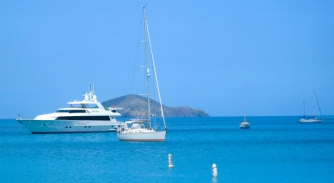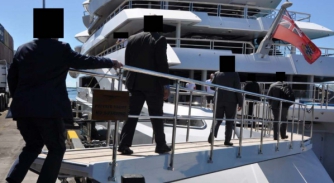Drawing the line between commercial and private use
Substance over weekends: private use inside commercial yacht structures is the EU-compliance frontier…
If there is one recurring misunderstanding in the superyacht world, it’s this: “Our yacht is commercially registered and sits in a leasing/charter structure – so a quiet owner weekend is fine.” Legally and fiscally across the EU, that single “quiet weekend” can unravel years of careful planning: deductions denied, VAT clawed back, customs reliefs lost, and – depending on the jurisdiction – requalification as a hidden profit distribution. The line between commercial and private is policed by hard rules and evolving case law. 2025 has made that line sharper, not softer.
The tripwire, simply stated
Whenever a yacht that is held in a commercial structure (SPV/OpCo‑PropCo/leasing) is in fact used privately by the UBO or related parties without robust business purpose, evidence and arm’s‑length pricing, EU systems react in three ways:
1. Direct tax – deduction of leasing/operating costs fails where they are not inherently connected to the trade; several Member States have bright‑line prohibitions.
2. VAT – private use of business assets triggers self‑supply rules unless accounted for correctly.
3. Customs – if the structure relies on Temporary Admission or specific reliefs, private use by the wrong person can collapse that relief.
Italy (2025): "Inerenza" sharpened – then applied to yachts
In 2025 the Corte di Cassazione consolidated a more functional, qualitative test of inerenza (inherence): costs are deductible when qualitatively connected with the concrete business activity, not by a rigid cost–revenue causation. But the same court also confirmed that where a yacht held by a company is factually used as a shareholder’s toy, inerenza fails and deductions go with it. Paper trails alone do not beat reality.
A yacht‑specific note published in September 2025 reports the Cassazione’s (Cassation’s) refusal of deductions on a luxury yacht in leasing because effective use was personal; merely housing the asset in a company and asserting charter intent was insufficient. Expect tax authorities to mirror that approach in audits.
So what? Italian 2025 jurisprudence gives taxpayers more room where there is a genuine business project; it gives no shelter where the yacht’s pattern of use is private. The burden of proving business connection remains very real.
France: “Dépenses somptuaires” and the dividend boomerang
France has long‑standing legislation barring deduction of expenses tied to yachts (CGI art. 39, 4). Administration guidance (BOFiP – Bulletin Officiel des Finances Publiques-Impôts) allows narrowly framed exceptions if the taxpayer proves the business necessity. In practice, the bar is high: courts have upheld that such expenses can be recharacterised as distributed income to managers/shareholders – even where the company shows no taxable profit that year. That is the fiscal boomerang effect owners often overlook.
Germany: statutory ban plus blocked input VAT
Germany’s § 4(5) sentence 1 no. 4 EStG (German Income Tax Act) flatly disallows expenses for sailing/motoryachts and similar purposes (save where the yacht operation is itself the profit‑seeking business). The rule extends into VAT via § 15(1a) UStG (VAT): when the expense is non‑deductible income‑tax wise, input VAT is typically blocked too, a position confirmed by the Federal Fiscal Court (BFH). Result: for most non‑charter trades, yacht costs are out, period.
Spain: proof, proof, proof – plus matriculation‑tax traps
Spain’s tribunals and AEAT (Spanish Tax Administration Agency) guidance keep a strict line: expenses are deductible only with credible evidence of exclusive business use. A 24 June 2025 Tribunal Económico-Administrativo Central (TEAC, Spain’s Central Economic-Administrative Court), doctrine reiterates that the taxpayer must prove exclusive business use to deduct mixed‑use assets – an approach readily applied by analogy to yachts.
On top, Spain’s Impuesto Especial sobre Determinados Medios de Transporte (IEDMT) (matriculation tax) offers a charter exemption, but conditions are tight; owner/related‑party use inconsistent with genuine chartering risks the exemption and invites retroactive taxation. Industry guidance underscores that the charter exemption hinges on actual, exclusive charter activity with formal pre‑clearance and ongoing compliance.
Netherlands: private enjoyment becomes a “winstuitdeling”
In the Netherlands, costs that satisfy an owner’s private needs via the company can be treated as a profit distribution (winstuitdeling), non‑deductible under Article 10(1)(a) CITA 1969, and taxable at shareholder level. The “double‑awareness” test in case law asks whether both company and shareholder knew of the benefit without business justification; where yes, corporate deductions fail and dividend tax consequences follow.
Malta: “wholly and exclusively” meets commercial codes
Malta’s rule is orthodox: only expenses wholly and exclusively incurred in the production of income are deductible; domestic/private expenses are expressly excluded. For commercially coded yachts under the Commercial Yacht Code (CYC 2025), heightened compliance duties go hand‑in‑hand with the expectation of genuine charter activity. If owner enjoyment creeps in without proper chartering formalities and pricing, both the wholly‑and‑exclusively test and VAT positions are at risk.
VAT and customs: two invisible currents most owners underestimate
VAT self‑supply: the EU VAT Directive taxes private use of business assets, either as a deemed supply of goods (Art. 16/18) or supply of services (Art. 26), depending on whether the use is final or temporary. If you deducted input VAT on the yacht or its costs and then use the yacht privately, you generally must charge VAT on that private use and keep proportionate records.
Temporary Admission (TA): for non‑EU yachts, the EU allows private use under TA for limited periods (normally 18 months), but the holder is expected to be established outside the EU. Misuse can create customs/VAT debts. Keep clean entry/exit evidence and user‑residency proofs.
The “owner‑weekend” that can work: a test you must pass every time
4. Arm’s‑length chartering of owner use – Treat any owner/related‑party time on board as a fully fledged charter, at market rate, invoiced, paid in cash flow (not journalled), with VAT where due, and with the same MYBA‑style documentation you would require from a third party.
5. Evidence over narrative – “Business plan” language does not win audits; logs, AIS tracks, charter calendars, crew timesheets, marketing, third‑party bookings and bank evidence do.
6. Segregate the enterprise – If the trade is yacht charter, run it like one: dedicated entity, staff/management agreements, third‑party revenue share and governance that would pass an arm’s‑length smell test.
Quick comparative snapshot (EU focus)
Italy – 2025 Cassation consolidates qualitative inerenza; yacht use by shareholder without business connection = no deduction.
France – CGI art. 39(4) bars yacht expenses; burden of proof sits with taxpayer to escape the “somptuary” box; recharacterisation as distributions possible.
Germany – § 4(5) no. 4 EStG denies deductions for yachts; input VAT exclusion typically follows (§ 15(1a) UStG). Only genuine charter operators escape.
Spain – Deductibility hinges on proving exclusive business use; TEAC 24‑06‑2025 emphasises proof burdens; IEDMT charter exemption requires strict compliance.
Netherlands – Private enjoyment via company → winstuitdeling (hidden dividend) and non‑deductibility under Art. 10(1)(a) CITA; dividend taxation at shareholder level may follow.
Malta – Wholly‑and‑exclusively rule; CYC 2025 tightens commercial oversight. Owner time must be chartered and evidenced to preserve deductibility/VAT positions.
The operational checklist we use with owners
Before the season
• Document a commercial plan with budgets, breakeven, and targeted third‑party weeks; sign management and central‑agent mandates that show real market exposure.
• Map VAT: identify where owner charters trigger VAT, how self‑supply rules apply and how you will account for mixed use (pro‑rata or chargeable private‑use entries).
• Customs status: confirm VAT‑paid, inward processing, or Temporary Admission and who may use the yacht under that status. Capture entry/exit evidence.
During owner use
• Issue MYBA‑style charter paperwork, invoice at market rate, charge VAT where due and take cash‑flow payment. Record guest lists, AIS, crew timesheets.
• Keep logbook entries distinguishing owner and third‑party charters; ensure no crew or fuel cost masking of private weekends.
After the season
• Prepare a deductibility file per jurisdiction (IT inerenza memo; FR somptuary rebuttal; DE § 4(5) EStG exception only if you truly charter; ES evidence bundle; NL dividend‑risk analysis; MT wholly‑and‑exclusively memo).
Five red flags auditors love
7. Owner weekends booked as “marketing” with no third‑party charter pipeline, relevant fair, presentation or conversion.
8. Zero or token third‑party income over multiple seasons while claiming full deductions.
9. No VAT entries for private use despite full input VAT deduction on capex/OPEX.
10. Temporary Admission yacht used by an EU‑established user or without exit/entry proofs.
11. Intra‑group “paper charters” at below‑market rates or paid by journal entries.
What are the changes in 2025?
• Italy has clarified how to test business connection; it did not bless lifestyle costs. If the conduct is private, the deduction dies.
• Malta issued CYC 2025, raising oversight on commercial yachts. The compliance delta between real charter trade and private yacht in disguise widens.
• Netherlands and France continue to police shareholder benefits and somptuary expenses via recharacterisation tools rather than form – substance leads.
Bottom line for owners and managers
A commercially registered yacht is not a fiscal invisibility cloak. If you want private time on board inside a commercial structure, build it on three pillars – arm’s‑length pricing, contemporaneous evidence, and jurisdiction‑specific rules – or treat the costs as non‑deductible and account for VAT/self‑supply. Anything in between invites reclassification (Italy), somptuary denial/dividend (France), statutory prohibition (Germany), proof‑failure and IEDMT exposure (Spain), dividend recharacterisation (Netherlands) or wholly‑and‑exclusively failure (Malta).
Key sources (selection)
EU VAT Directive: Articles 16, 18, 26 (self‑supply/private use).
EU customs/Temporary Admission: Commission guidance (18‑month limit; non‑EU establishment requirement).
Italy: Cassation Ordinance 11 Aug 2025, n. 23095 (inerenza test); yacht‑specific case note (Sept 2025).
France: CGI art. 39(4) & BOFiP notes; Conseil d’État 24 Jun 2024 (distributed income from yacht expenses).
Germany: § 4(5) no. 4 EStG; BFH confirming linkage to input VAT block via § 15(1a) UStG.
Spain: TEAC 24 Jun 2025 (proof of exclusive business use); AEAT corporate non‑deductibles; IEDMT charter exemption conditions.
Netherlands: Article 10(1)(a) CITA 1969 (non‑deductibility of profit distributions); winstuitdeling doctrine.
Malta: Cap. 123 (Income Tax Act) – wholly and exclusively; Commercial Yacht Code 2025.
Conributor’s comment: This article is a general note for industry readers of SuperyachtNews. It is not legal or tax advice. For owner‑use planning inside commercial set-ups, we recommend a jurisdiction‑by‑jurisdiction advice with specialised counsel.
As an open-source platform we offer an industry-wide invitation to anyone and everyone in our sector to share their knowledge, experience and opinions. So if you have an interesting and valuable contribution to make, and would like to join our growing community of guest columnists, share your ideas with us at newsdesk@thesuperyachtgroup.com
NEW: Sign up for SuperyachtNewsweek!
Get the latest weekly news, in-depth reports, intelligence, and strategic insights, delivered directly from The Superyacht Group's editors and market analysts.
Stay at the forefront of the superyacht industry with SuperyachtNewsweek
Click here to become part of The Superyacht Group community, and join us in our mission to make this industry accessible to all, and prosperous for the long-term. We are offering access to the superyacht industry’s most comprehensive and longstanding archive of business-critical information, as well as a comprehensive, real-time superyacht fleet database, for just £10 per month, because we are One Industry with One Mission. Sign up here.
Related news

Shifting tides in superyacht law
Francesca Conn, Legal Director at Hill Dickinson, on what the MYBA Charter 2025 terms mean for brokers
Opinion

Fragmented EU customs rules leave yacht owners exposed
Conflicting EU customs rules risk massive VAT bills for superyachts. A recent case exposes why harmonised enforcement is urgently needed across member states
Business

Turning legal limbo to public value
Emmanuelle Votat calls for a European framework to manage frozen and seized yachts ethically and transparently based on lessons from judicial practice in France
Opinion

“Not too late to change tack!”
European Boating Industry statement on EU tariffs on US recreational boats
Business

New laws to affect export of luxury artefacts to EU
With new regulations affecting the export of cultural goods and fine art to the EU, Alinea Customs and Art On Superyachts offer course to help navigate the chan
Owner
Related news
Shifting tides in superyacht law
4 months ago
Turning legal limbo to public value
5 months ago
“Not too late to change tack!”
7 months ago
New laws to affect export of luxury artefacts to EU
7 months ago
NEW: Sign up for
SuperyachtNewsweek!
Get the latest weekly news, in-depth reports, intelligence, and strategic insights, delivered directly from The Superyacht Group's editors and market analysts.
Stay at the forefront of the superyacht industry with SuperyachtNewsweek



